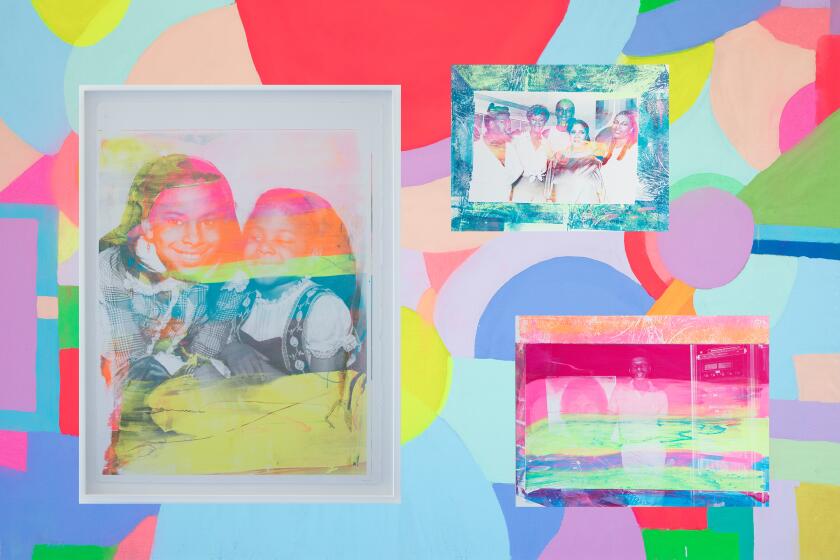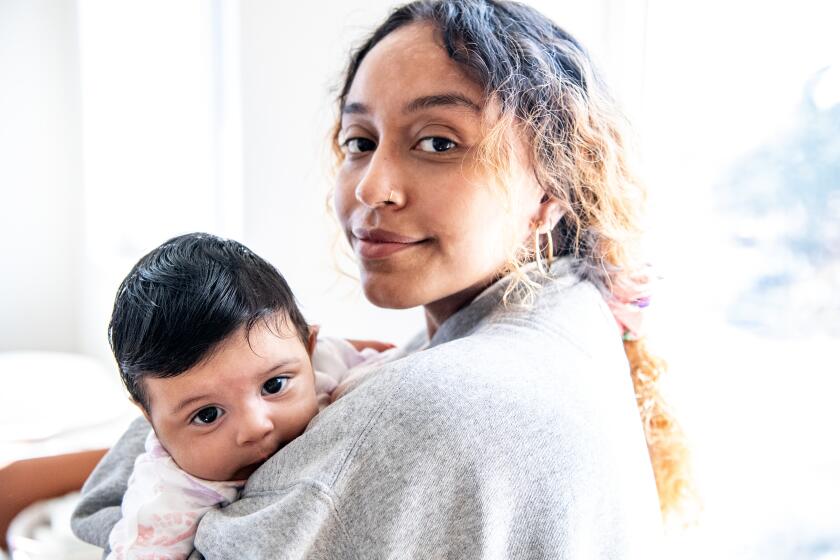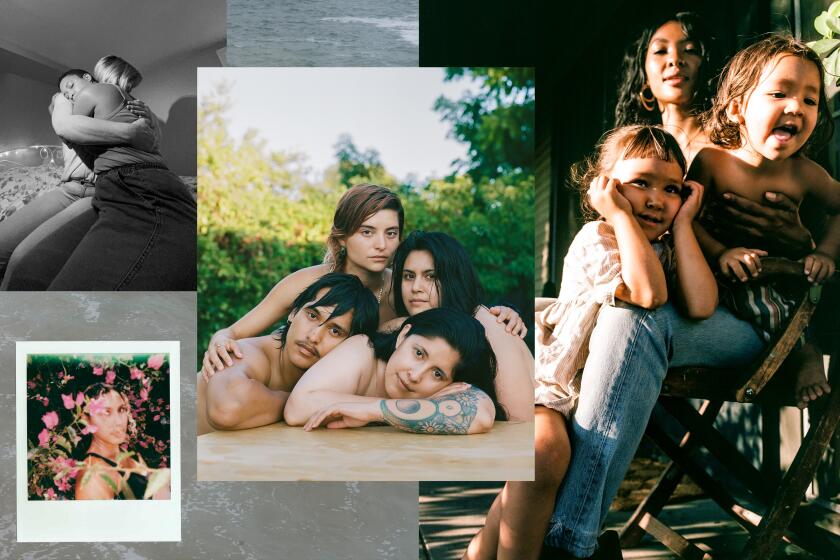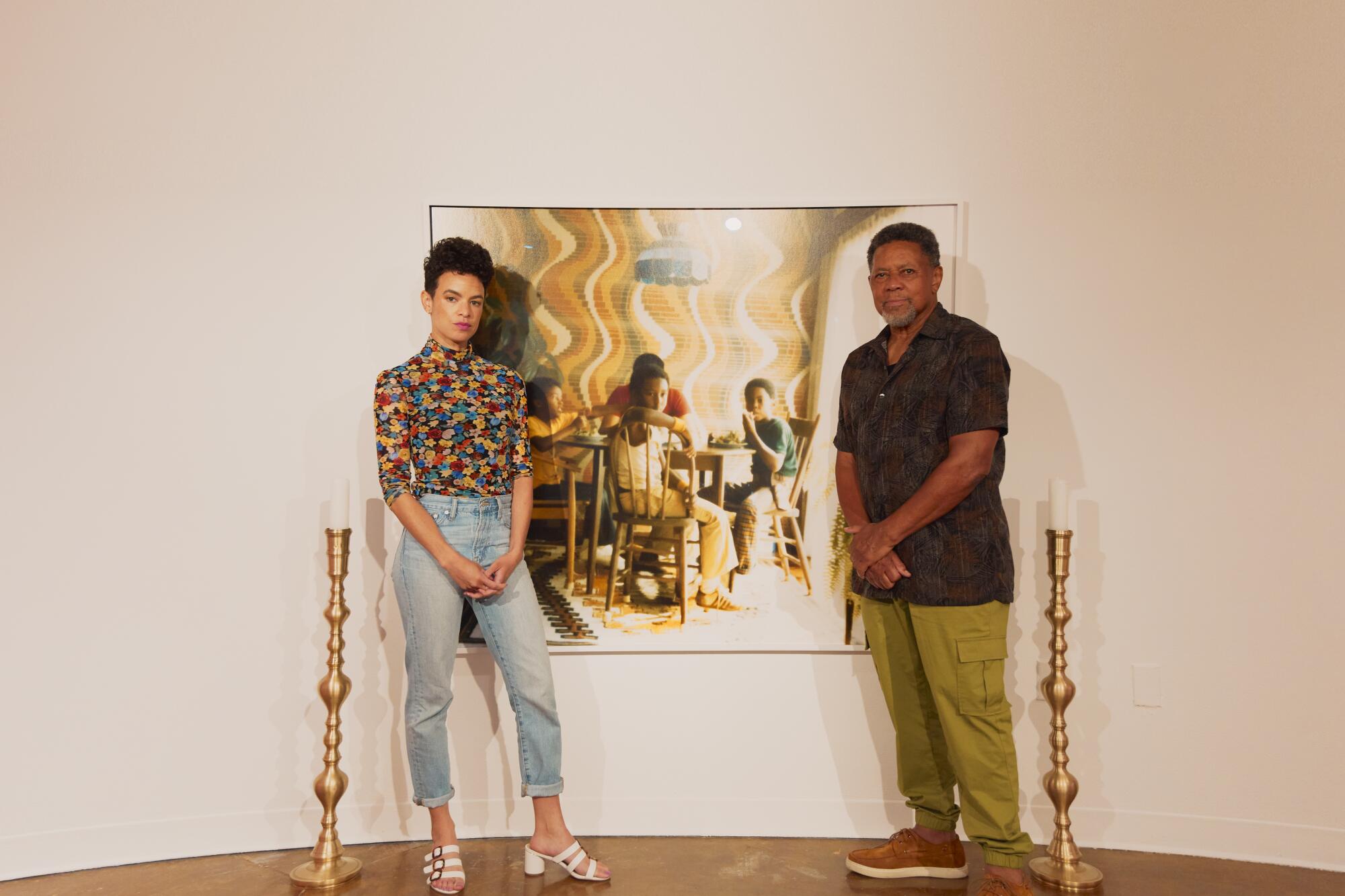
- Share via
This story is part of Parents Are Cool!, the third issue of Image, which explores the myriad ways in which L.A. parents practice the craft of care. See the full package here.
The care can be found first in the premise. The couch, the end tables, the art on the walls, the books, the faces in the photos, the candle holders — each of these articles is intended to show proof of life. Someone, though it’s not clear who. A family, surely. Maybe a large one with at least one young daughter. The arrangement of items in the room looks like a memory, but more vivid, less abstract. In a word, real. There’s a stack of speakers on the wall with a slightly dented, presumably empty beverage can resting on top. A party was clearly here. One wonders where the function let out to.
Warmth radiates from the work of artist Sadie Barnette. But it’s not just present at the crib or in the backyard; it appears in darker, more banal and bureaucratic settings too. Barnette’s new exhibition, “Legacy & Legend,” which jumps between the Benton Museum of Art at Pomona College and Pitzer College Art Galleries, centers on the life of her father, Rodney — specifically, how he was terrorized, surveilled, intimidated and nearly killed by the FBI and Cointelpro because of his activism with the Black Panthers, Angela Davis and other organizations. In a series of large, 60-by-48-inch drawings that re-create a dossier compiled by the FBI — a sprawling, 500-page document filled with obvious untruths and innuendo — Sadie Barnette transforms and reclaims her father’s narrative, her family’s history.
Together, the drawings and the immersive space — with the couch — function as an act of preservation, restoration. “You can surveil all the actions,” she tells me. “You can’t surveil our souls and our love.”
Recently, I caught up with both Barnettes to talk about Sadie’s work, “Legacy & Legend,” and healing through art and activism. Our conversation has been lightly edited and condensed for clarity.
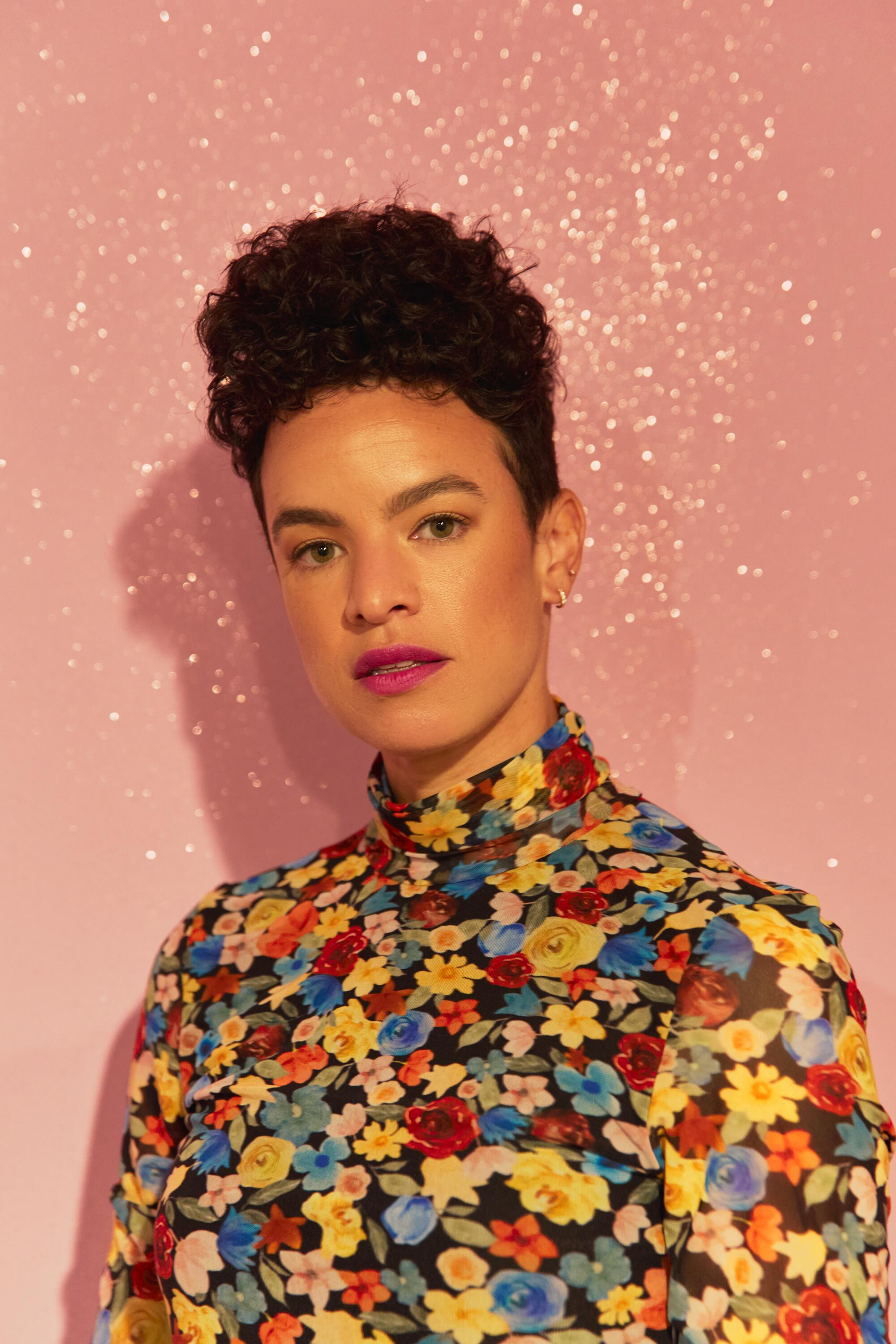
Ian F. Blair: So much of your practice is archival. It’s rooted in thinking about the past, what its meaning is going to be. Where did that come from?
Sadie Barnette: I’ve always just been amazed at my family. The beauty, the strength. And I’ve always been a little bit of a shy person. I think that’s why I started out with photography, because it’s a way to participate in a moment. You’re a little bit outside of the moment, you’re capturing the moment, you’re thinking about the moment when it’s passed. Capturing that story and wanting to hold on to it, wanting to preserve it. Then also wanting to share it, wanting to blow it up, bigger than life size, and kind of make monumental those tiny, everyday moments. Making pictures feels kind of like magic — kind of like science and art.
More stories from Image
Melina Abdullah talks to Angela Flournoy about how we can all get to freedom
These L.A. photographers offer a vision of what parenting can be
Dave Schilling unpacks L.A.’s obsession with dad hats
Essence Harden and Adee Roberson reimagine art as a commitment to each other
Julissa James speaks with Hike Clerb founder Evelynn Escobar about the first 40 days of postpartum motherhood
IFB: In “Legacy & Legend,” the first thing that jumps out to me is the cover of the FBI file. It really lays the foundation for what you’re trying to do — giving appropriate context to your family’s history, your personal history.
SB: You kind of can’t believe that the archive delivers you this ready-made thesis for the work. [I was] trying to flip that around and use the language of the state and of the FBI to put it in our voice. When it’s coming out of our mouth, obviously the context changes. It’s like, “Do not destroy the movement, do not destroy our lives, do not destroy our families.” Restoration is how I think about it, especially when I’m rendering these in graphite. It is time and labor really spent with each text and each page. It really allows for a process of reclamation, a process of alchemy, that can sort of undo some of the violence and pain and loss. It’s not gonna actually undo those things, but [it can] shine a healing light.
IFB: I’m curious to know more about this process of graphite. How does it work?
SB: Basically, everything is designed on the computer. And then I create stencils, and lay down stencils, and use powder, graphite, in a kind of almost painterly, rubbing process that really sinks into the paper. And then when you peel up the central, that’s when you get the white negative space. I inverted the white as black. There’s [something] ghostly about seeing the negative.
IFB: Like a copy machine.
SB: Yeah. When I received the file, it was a digital document. But of course, it’s analog in its creation.
IFB: I love the spray paint flourishes.
SB: Graffiti claims space. Says that you were here, or that this was yours. I definitely was thinking about spray painting on those files as claiming them. Also, wanting to have a hand gesture, but not something as direct as like scribbling. Because that felt a little bit too emotive. I wanted to still protect myself. [There’s] one level of removal: It’s not their hand; it’s a little bit more anonymous.
IFB: It definitely lends a dynamic quality to the work. Rodney, I wanted to hear a little bit more about the story behind this work.
Rodney Barnette: Here’s what happened. A new office opened up in Los Angeles. People wanted to implement the 10-point program, to create free breakfast programs for the children, set up medical clinics for people who needed medical attention. And my job was to organize. I was talking to the religious organizations. I was dangerous because I was talking to the group of ministers. I ended up opening an office in Compton, which was the ninth office in the local L.A. area. We first started having meetings, we got more people interested. But not too long after that I was called into the office by somebody I didn’t even know. They said that they were from Panther Underground. They were telling me that I had to start disciplining the members in Compton — beating them if they were late to the meetings — but this was a new person who I had never met before. I’m not going to do that. So that’s what happened. That’s how I left.

IFB: One of the things that‘s really jarring about these drawings of your FBI file is the multiple ways in which the feds invaded your life. What were some other ways they infiltrated that you didn’t realize at the time but now know thanks to the dossier?
RB: Let me tell you: There are a couple of things that I always wondered whether I had been the victim of an FBI agent. One of them was that I had a meeting with some guys [in Irvine]. We were coming back from the meeting. We’re in a VW bus. I’m in the backseat and the lights keep getting brighter and brighter, and boom! A truck hit us and turned that car over three times. Still, whenever cars come up behind me and the lights start getting brighter kind of freaks me out.
I didn’t realize how widely the FBI and the LAPD were infiltrating our organization. They started off down here in L.A. by sending a letter from the Panthers to another “rival” organization — US — saying, “We’re going to kill you!” And they sent a letter from them to the Panthers saying that. The Panthers were invited to talk, give presentations at UCLA. Some of the US organization people went there also. And they shot and killed two of the Panthers. This FBI agent instigated the whole thing, and probably is the one who did the shooting, and disappeared. So they did that stuff.
L.A. artist interview: Adee Roberson on family, friendship
IFB: What are some of the smaller ways in which they kind of infiltrated your life?
RB: They had a campaign against me. I have nine brothers, eight brothers and two sisters, and they would go to their houses. I had a sister who applied for a job, and they brought up that I was in the Panthers questioning her patriotism. [The FBI] went back to my hometown when I went to school and talked to neighbors. Intimidating people. I lost my job.
IFB: One thing the government was worried about was your work with Angela Davis. What did that work look like?
RB: She was locked up. So we knew we had to organize, publicize it, show she was being framed, and so forth. When Angela got out on bail, I wound up being responsible for Angela’s security. We lived together in San Jose.
IFB: What was it like to be on Angela Davis’ security detail?
RB: It was a big responsibility. The main thing was that she got out on bail, and she could not be late.
IFB: What were you driving?
RB: It was the old raggedy Mustang.
IFB: Sadie, how did growing up hearing these stories spark your curiosity?
SB: My dad is a very humble person, and he wasn’t, you know, walking around saying, “Oh, I did this and I did that.” He was very much, I think, living in the present. My dad was a union organizer representing nurses and farmworkers and all kinds of things. But when we actually got the FBI file, I think that was more of a container for the conversations that maybe we weren’t really having.
You know, I think there’s also a lot of painful things that happened during that time. It’s not like every time you sit down to dinner, you want to talk about the Panthers — so many lives were lost, people were assassinated, people are still incarcerated, families ripped apart, marriages ripped apart. I think once we got the file, we both had the sense [that] telling the story is bigger than just our family. There’s so many other families who are affected.
L.A. artist interview: Adee Roberson on family, friendship
IFB: With the Pitzer exhibit you’ve created this intimate space that exists, at least somewhat, outside of the gaze of surveillance. There’s something you can’t really quite see, even though there’s obviously all this surveillance around you.
SB: I wanted to point to a world that exists outside of, you know, the lens of state surveillance, outside of gentrification, outside of police brutality, outside of all of these things. Even if that place actually only exists internally or with the bonds that we have with each other. The living room kind of spaces are more imagined. You can surveil all the actions, you can’t surveil our souls and our love. To me, that’s what those spaces are about: how we create refuge for each other, and how we live our lives. Even if we aren’t winning the long-term political trajectory towards justice and basic needs being met for everyone around the world, we’re not waiting for that to happen to be magical, amazing, beautiful, stylish, poetic people. Even amongst all of this repression, there was dance parties — so many dance parties — and people are falling in love, and people are having babies. And, to me, that’s what those kind of glitter spaces represent.
IFB: There’s an obvious connection there between what you just described, and what the actual Black Panthers were doing. Taking initiative, creating these warm environments, feeding people, taking care of basic needs.
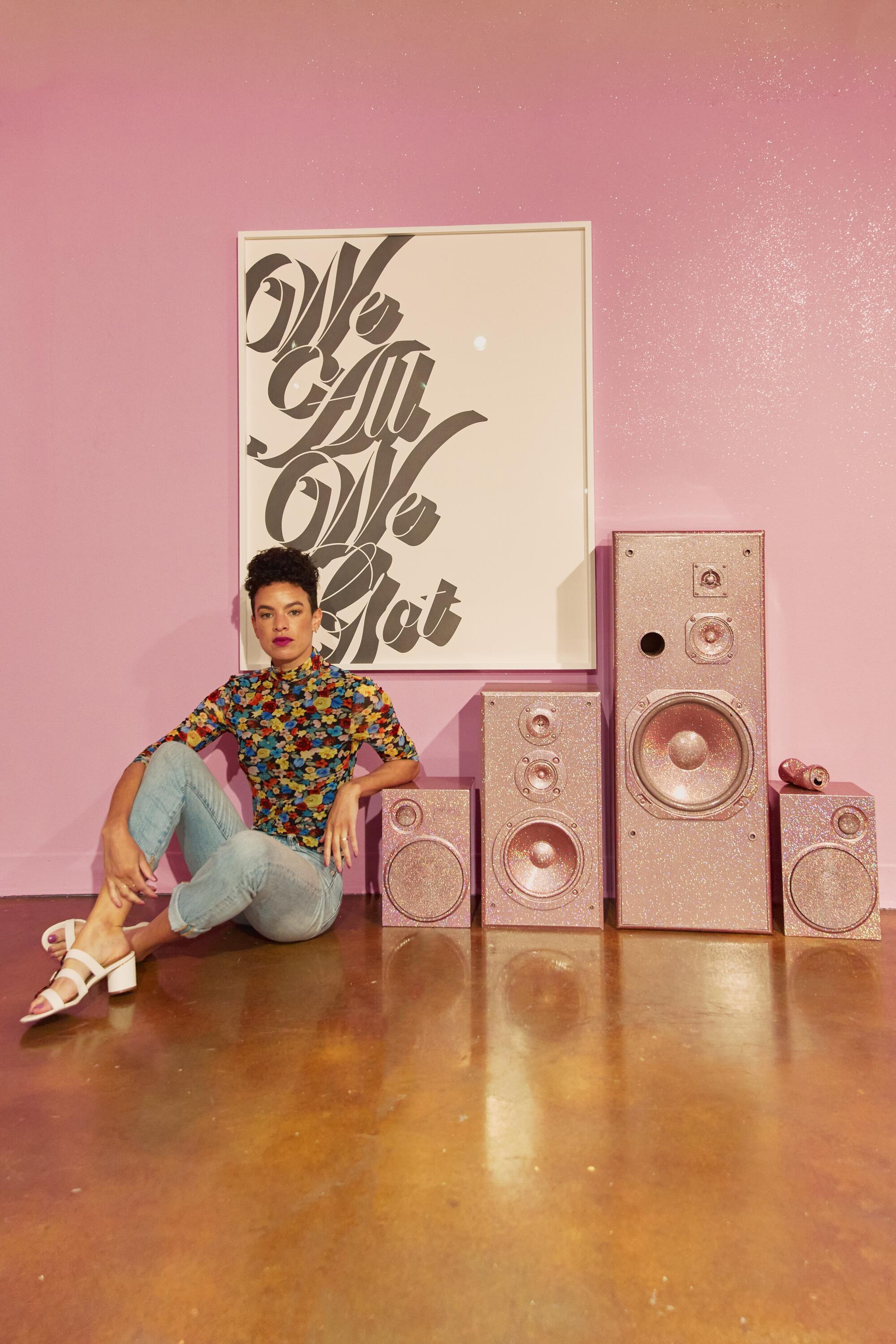
SB: I think a lot of the warmth of those spaces comes from like seeing my aunties and some of the matriarchs of our family create those spaces. Everybody has people in their family who’ve done amazing things. You know, heroes. I have one uncle who was a scientist and basically helped invent the battery that was in pacemakers. He wasn’t famous. I just always thought there’s so much talent and legacy in our family, but it’s just regular family. And every regular family is full of amazing people, especially Black families, because you’re not going to survive without having a certain degree of excellence, magic, bravery.
IFB: Speaking of family, there’s a real collaborative feel to your work. This element of passing down narratives. Maybe you can tell me a little bit more about that.
SB: It definitely takes a village. My mom is very involved. And when it comes to the actual artwork, I’m extremely specific. I’m an artist before anything else — very meticulous, precise, super controlling. Everything has to be a certain way. But it’s really important to me that my dad is a participant. A lot of times these projects don’t happen until, unfortunately, someone has passed away and they don’t get to tell their own story. But I love that we have different kinds of roles.
